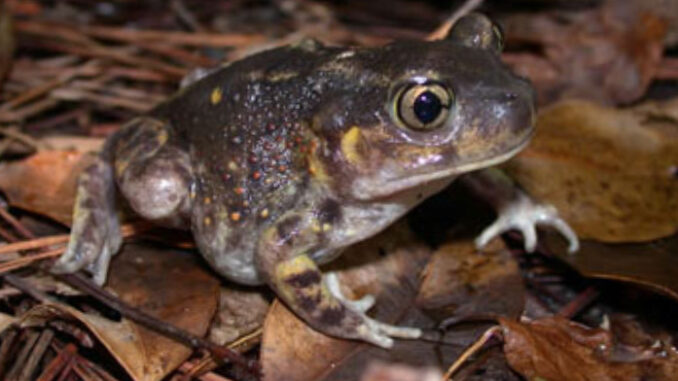
Our other toxic toad
Imaging sleeping for eleven months only to be awakened by the rumble of thunder during the summer monsoon. Then things get very busy. Listen for their bleating cries in the night.
Amphibians have a tough time in the desert. But one such critter, Couch’s Spadefoot (Scaphiopus couchi), has it down. Often called “spadefoot toads” these toad-like creatures, to purists, are not “true toads” because, among other things, they lack the toxin-secreting parotid gland common to true toads. However, toad lickers beware, according to the Arizona-Sonoran Desert Museum, “Couch’s spadefoots have a skin secretion that may cause allergic reactions in some humans. Cuts and scratches may become painful, and sneezing and discharge from the eyes and nostrils may also result from the handling of this amphibian.” So leave them alone. The photo below is from the Arizona-Sonora Desert Museum’s digital library. Click here for more spadefoot photos.
Couch’s spadefoot is about 3 inches long, has smooth yellowish, greenish, or olive-colored skin with irregular spots of green, brown, or black. It is common in the Tucson Mountains and occurs throughout the Sonoran Desert. They seem to prefer well-drained, sandy soil that supports creosote bush and mesquite. They also occur in grasslands, cultivated fields, and along desert highways.
The way spadefoots beat the heat is by estivating (hibernating) underground for about 11 months. They come out during the summer monsoon. They are extremely sensitive to low-frequency vibrations caused by rainfall and thunder.
When monsoon rains form shallow, ephemeral pools, the spadefoots get the signal and come to the surface, tens of thousands of them, on a single night. And they are noisy. As soon as they emerge, the males set up a chorus of bleating that sounds like sheep or goats; the females eat. The males then silently cruise the ponds in search of a female and eat afterwards. Both males and females eat beetles, grasshoppers, katydids, ants, spiders, termites, fairy shrimp, and almost anything else they can find. They have to eat enough in a few days to last them a year.
A single female can lay 1,000 eggs during one night. The eggs can hatch in as little as 15 hours, and tadpoles can metamorphose into tiny toadlets (one could fit on a dime) in 9 to14 days. During the day, the adults use their spaded feet to dig into the mud. Until toadlets are big enough to dig, they seek cracks in which to hide from the sun.
All will feed until the ephemeral pond is gone, then dig into the mud to wait for next year, and the rumble of thunder.
See also:

